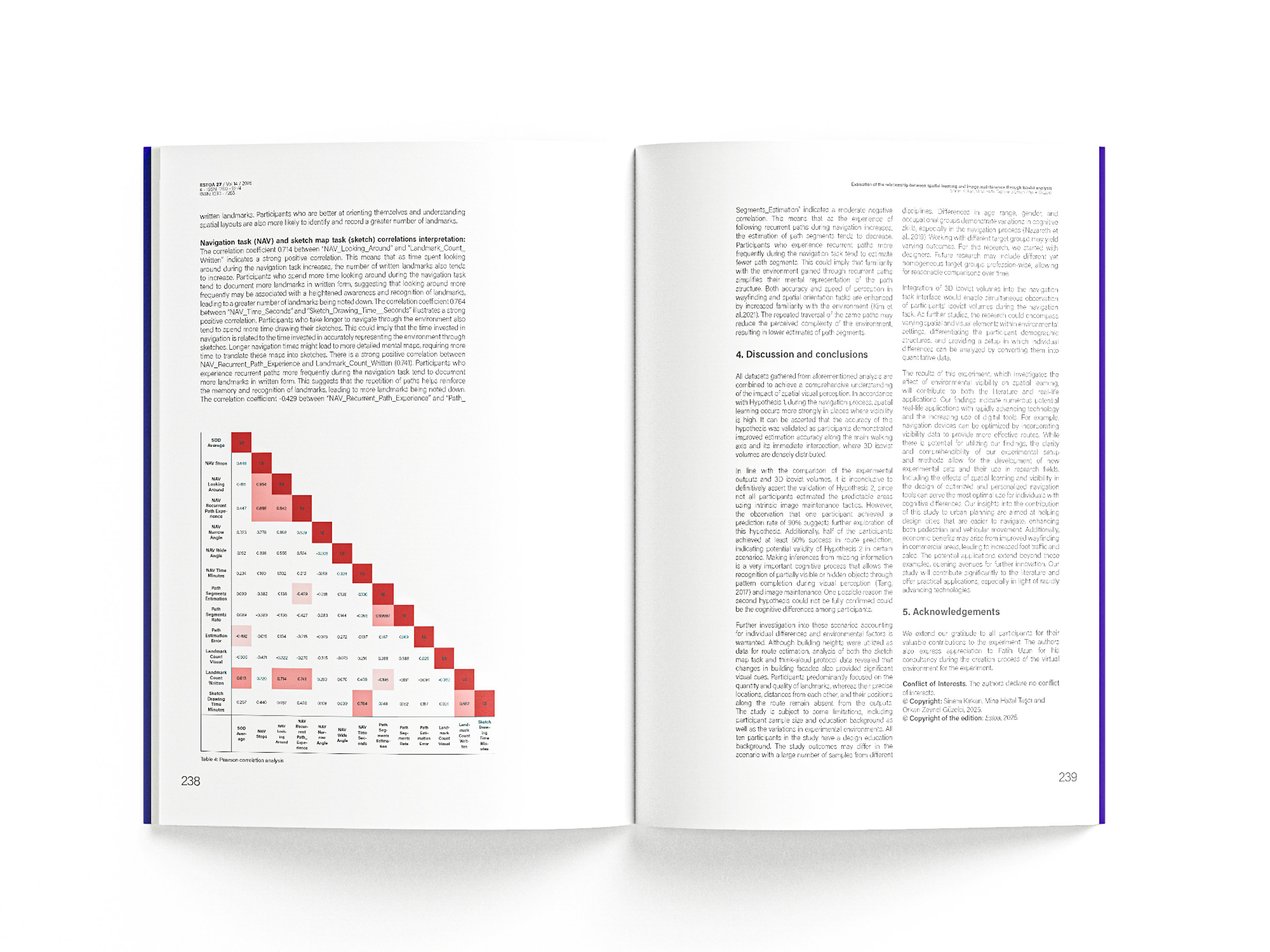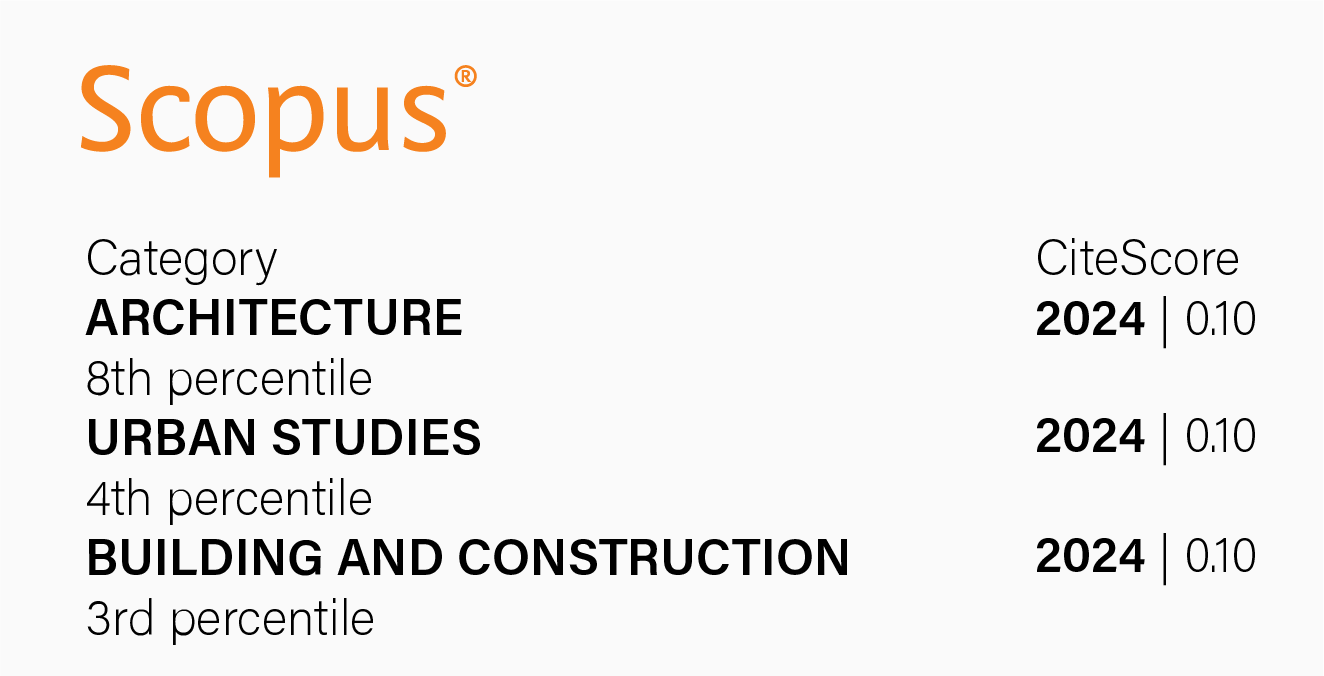Evaluation of the relationship between spatial learning and image maintenance through isovist analysis
DOI:
https://doi.org/10.18537/est.v014.n027.a14Keywords:
3D isovist, image maintenance, spatial visibility, spatial learning, navigationAbstract
This study presents a method, 3D parametric isovist volumes, to examine the relationship between ‘spatial visibility’ and ‘image maintenance’. The method assesses spatial visibility using 3D isovist analysis and investigates whether people complete a route using the ‘image maintenance’ method in places with limited visibility. The proposed method was applied in a three-phase case study involving ten participants from a design education background. The study employed a questionnaire, a navigation task, and a sketch-map task. Initial results indicate that spatial learning is more effective in areas with high visibility during the navigation process. However, spatial learning in low-visibility areas cannot always be predicted using the ‘image maintenance’ method or the data obtained from ‘spatial cues’.
Downloads
References
Ahmadpoor, N., & Smith, A. D. (2020). Spatial knowledge acquisition and mobile maps: The role of environmental legibility. Cities, 101.
Benedikt, M. (1979). To Take Hold of Space: Isovists and Isovist Fields. Environment and Planning B Planning and Design 6(1), 47–65.
Benedikt, M. & Burnham, C. A. (1985). Perceiving architectural space: From optic arrays to isovists. In: W. H. Warren, Jr. & R. E. Shaw (Eds.), Persistence and Change, 103–114. Psychology Press.
Benedikt, M. L., & Mcelhinney, S. (2019). Isovists and the metrics of architectural space. Proceedings 107th ACSA Annual Meeting, 1–10. https://www.researchgate.net/publication/331304881_Isovists_and_the_Metrics_of_Architectural_Space_preprint
Burte, H., & Hegarty, M. (2013). Individual and Strategy Differences in an Allocentric-Heading Recall Task. Proceedings of the Annual Meeting of the Cognitive Science Society, 35.
Chan, H. M., Ding, J., & Saunders, J. A. (2023). Does viewing an environment without occluders improve spatial learning of a large-scale virtual environment? Journal of Environmental Psychology, 92, 1–13.
Cumming, J., & Eaves, D. L. (2018). The Nature, Measurement, and Development of Imagery Ability. Imagination, Cognition and Personality, 37(4), 375-393. https://doi.org/10.1177/0276236617752439
Dalton, R., Dalton, N. S, McElhinney, S., & Panagiotis, M. (2022). Isovist in a Grid: Benefits and limitations. Proceedings 13th International Space Syntax Symposium, 551. Western Norway University of Applied Sciences, Department of Civil Engineering.
Davis, L. S., & Benedikt, M. L. (1979). Computational models of space: Isovists and isovist fields. Computer Graphics and Image Processing, 11(1), 49–72.
Derix, C., Gamlesæter, Å., & Carranza, P. M. (2008). 3d Isovists and Spatial Sensations: Two methods and a case study. In: S. Haq, C. Hölscher & S. Torgrude (Eds.), Movement and Orientation in Built Environments: Evaluating Design Rationale and User Cognition, 67-72. Universitat Bremen.
Dong, W., Qin, T., Yang, T., Liao, H., Liu, B., Meng, L., & Liu, Y. (2022). Wayfinding behavior and spatial knowledge acquisition: Are they the same in virtual reality and in real-world environments?. Annals of the American Association of Geographers, 112(1), 226–246.
Emo, B., Hölscher, C., Wiener, M. J., & Dalton, R. C. (2012). Wayfinding and Spatial Configuration: Evidence from street corners. Proceedings of Eighth International Space Syntax Symposium, 1–16.
Ericsson, K. A., & Simon, H. A. (1993). Protocol analysis: Verbal reports as data (Revised Edition). The MIT Press.
Fan, P. Y., Chun, K. P., Mijic, A., Tan, M. L., Liu, M. S., & Yetemen, Ö., (2022). A framework to evaluate the accessibility, visibility, and intelligibility of green-blue spaces (GBSs) related to pedestrian movement. Urban Forestry & Urban Greening, 69.
Fisher-Gewirtzman, D. (2018). Integrating ‘weighted views’ to quantitative 3D visibility analysis as a predictive tool for perception of space. Environment and Planning B: Urban Analytics and City Science, 45(2), 345–366.
Gath-Morad, M., Thrash, T., Schicker, J. et al. (2021). Visibility matters during wayfinding in the vertical. Sci Rep 11, 18980
Gibson, J. J. (2014). The ecological approach to visual perception (Classic Edition). Psychology Press.
Goldschmidt, G. (1991). The dialectics of sketching. Creativity Research Journal, 4(2), 123–143.
Hahm, J., Lee, K., Lim, S. L., Kim, S. Y., Kim, H. T., & Lee, J. H. (2007). Effects of active navigation on object recognition in virtual environments. CyberPsychology & Behavior, 10(2), 305–308.
Hegarty, M., Montello, D. R., Richardson, A. E., Ishikawa, T., & Lovelace, K. (2006). Spatial abilities at different scales: Individual differences in aptitude-test performance and spatial-layout learning. Intelligence, 34(2), 151–176.
Hölscher, C., Brösamle, M., & Vrachliotis, G. (2012). Challenges in multilevel wayfinding: A case study with the space syntax technique. Environment and Planning B: Planning and Design, 39(1), 63–82.
Hughes, S., & Lewis, M. (2005). Attentive navigation for viewpoint control in virtual environments. Human Factors, 47(3), 630–643.
Ishikawa, T. (2021). Spatial thinking, cognitive mapping, and spatial awareness. Cognitive Processing, 22(S1), 89–96.
Kelly, J. W., & McNamara, T. P. (2010). Reference frames during the acquisition and development of spatial memories. Cognition, 116(3), 409–420.
Kim, G., Kim, A., & Kim, Y. (2019). A new 3D space syntax metric based on 3D isovist capture in urban space using remote sensing technology. Computers, Environment and Urban Systems, 74, 74–87.
Kim, J. Y., Choi, J. K., Han, W. H. & Kim, J. H. (2021) The Influence of Users’ Spatial Familiarity on Their Emotional Perception of Space and Wayfinding Movement Patterns. Sensors, 21(8), 2583. https://doi.org/10.3390/s21082583
Kondyli, V., & Bhatt, M. (2018). Rotational locomotion in large-scale environments: A survey and implications for evidence-based design practice. Built Environment, 44(2), 241–258.
Kondyli, V., Bhatt, M., & Hartmann, T. (2018). Precedent based design foundations for parametric design: The case of navigation and wayfinding. Advances in Computational Design, 3(4), 339–366.
Kosslyn, S. M., & Shin, L. M. (1991). Visual Mental Images in the Brain. Proceedings of the American Philosophical Society, 135(4), 524–532. http://www.jstor.org/stable/986814
Kosslyn, S. M., Thompson, W. L., & Ganis, G. (2006). The case for mental imagery. Oxford University Press. https://doi.org/10.1093/acprof:oso/9780195179088.001.0001
Krukar, J., Manivannan, C., Bhatt, M., & Schultz, C. (2021). Embodied 3D isovists: A method to model the visual perception of space. Environment and Planning B: Urban Analytics and City Science, 48(8), 2307–2325.
Lu, Y., & Ye, Y. (2019). Can people memorize multilevel building as volumetric map? A study of multilevel atrium building. Environment and Planning B: Urban Analytics and City Science, 46(2), 225–242.
Meilinger, T., Franz, G., & Bülthoff, H. H. (2012). From isovists via mental representations to behaviour: first steps toward closing the causal chain. Environment and Planning B: Planning and Design, 39(1), 48–62.
Metoyer, S. K., Bednarz, S. W., & Bednarz, R. S. (2015). Spatial thinking in education: Concepts, development, and assessment. In Geospatial Technologies and Geography Education in a Changing World: Geospatial Practices and Lessons Learned.
Nazareth, A., Huang, X., Voyer, D., & Newcombe, N. (2019). A meta-analysis of sex differences in human navigation skills. Psychonomic bulletin & review, 26, 1503-1528.
Qiu, X., Wen, L., Wang, Q., Li, H., & Wang, D. (2020). Impact of learning methods on spatial knowledge acquisition. Frontiers in Psychology, 11, 543783.
Rand, K. M., Barhorst-Cates, E. M., Kiris, E., Thompson, W. B., & Creem-Regehr, S. H. (2019). Going the distance and beyond: Simulated low vision increases perception of distance traveled during locomotion. Psychological Research, 83(7), 1349–1362.
Richardson, A. E., Montello, D. R., & Hegarty, M. (1999). Spatial knowledge acquisition from maps and from navigation in real and virtual environments. Memory & Cognition, 27(4), 741–750.
Roupé, M., Bosch-Sijtsema, P., & Johansson, M. (2014). Interactive navigation interface for virtual reality using the human body. Computers, Environment and Urban Systems, 43, 42–50.
Tandy, C. R. V. (1967). The isovist method of landscape survey. Methods of Landscape Analysis, 10, 9–10.
Tang, H., Schrimpf, M., Lotter, W., Moerman, C., Paredes, A., Caro, J., Hardesty, W., Cox, D., & Kreiman, G. (2017). Recurrent computations for visual pattern completion. Proceedings of the National Academy of Sciences of the United States of America, 115, 8835 - 8840.
Verghote, A., Al-Haddad, S., Goodrum, P., & Van Emelen, S. (2019). The effects of information format and spatial cognition on individual wayfinding performance. Buildings, 9(2), 29.
Van der Kuil, M. N. A., Evers, A. W. M., Visser-Meily, J. M. A., & van der Ham, I. J. M. (2021). Spatial knowledge acquired from first-person and dynamic map perspectives. Psychological Research, 85(6), 2137–2150.
Wiener, J. M., Franz, G., Rossmanith, N., Reichelt, A., Mallot, H. A., & Bülthoff, H. H. (2007). Isovist analysis captures properties of space relevant for locomotion and experience. Perception, 36(7), 1066–1083.

Published
How to Cite
Issue
Section
License
Copyright (c) 2024 Estoa. Journal of the Faculty of Architecture and Urbanism

This work is licensed under a Creative Commons Attribution-NonCommercial-ShareAlike 4.0 International License.
The Journal declines any responsibility for possible conflicts derived from the authorship of the works that are published in it.
The University of Cuenca in Ecuador conserves the patrimonial rights (copyright) of the published works and will favor the reuse of the same ones, these can be: copy, use, diffuse, transmit and expose publicly.
Unless otherwise indicated, all contents of the electronic edition are distributed under a Creative Commons Attribution-NonCommercial-ShareAlike 4.0 International License.



